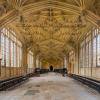II.2 'Universitas': the original meaning of the term
Commentary
‘Universitas’: a corporation of masters and students
According to its own website, 'The University of Oxford is a civil corporation established ... [in] 1571 under the name of "The Chancellor Masters and Scholars of the University of Oxford".' This formulation reflects the original, medieval conception of a university as a corporation of masters and students.
The word ‘corporation’ derives from corpus, the Latin word for body, which was also extended to designate a collective: a ‘body of people’. By the time Roman law was codified under the emperor Justinian (reigned 527–565), a range of corporate entities were recognized under the names universitas, corpus or collegium: these entities included cities, craft guilds, and (during the medieval period) churches. Incorporation of this kind ensured that the collective could survive the death of any of its individual members, potentially in perpetuity. It also allowed the collective to own property, make contracts, receive benefactions, and sue or be sued in a court of law. These and other privileges and liberties were granted by the emperor (and later by popes and monarchs) in the form of a charter.
The first ‘university’ in the academic sense formed in Bologna in the eleventh century, where students from various regions (called ‘nationes’) banded together to form a larger association – the universitas (Latin for ‘the whole’) representing the entire student community – as a means of increasing their bargaining power with the city. In the thirteenth century, corporations of students and masters such as these were granted formal charters, first by Emperor Friedrich II (for the university of Naples in 1224), then by Pope Gregory IX (for the University of Toulouse in 1229), and eventually by kings as well.
This image therefore represents the ‘universitas’ in its original sense as a formally constituted corporation of masters and students. More specifically, this manuscript illumination from 1537 depicts a formal academic meeting presided over by the chancellor. The three standing figures each bear a ceremonial mace, symbolising the authority of the university or one of its faculties. The meeting takes place in what appears to be a purpose-built room, with seating arranged in the manner of a church or cathedral choir.
Commentary. Howard Hotson (May 2018).

